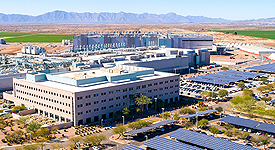Below are some answers to frequently asked questions about water quality.
Chandler’s Public Works and Utilities Department delivers 56 million gallons of drinking water every day to residents, industry and businesses.
More than 80 percent of the water in the USA is hard, so water hardness is not a phenomenon exclusive to the State of Arizona. Most health officials agree there is nothing detrimental to a person’s health regarding water hardness, and some studies even suggest hard water is beneficial. The United States Environmental Protection Agency has not established a maximum contaminate level for water hardness, and we are not aware of any pending proposals to establish one. In addition, 91% of our water is not used for household purposes, and of the remaining 9%, less than 1% is consumed. If the City were to add additional treatment, the cost would be much higher, and with less than 1% of the water being consumed, it would not be economically practical. Chandler’s drinking water does satisfy and, in some cases, exceeds the requirements of the Safe Drinking Water Act
The City of Chandler strives to maintain chlorine residual between 1.0 and 2.0 mg/L. Generally, the distribution system water has a chlorine residual of 1.6 mg/L
First, check all your faucets to determine if it is an isolated problem or if it is throughout the house. If it is throughout the home, check the flow coming from the outside hose bib at the front of your home. If the flow appears to be good there, you probably have an internal problem. You can check the following:
Check your aerators to make sure there is no debris restricting the flow. Check your house isolation valve to make sure it is open completely. If none of the above improves the pressure and you have a water softener, place it into the "bypass" mode, then check your pressure to see if it has improved.
The City of Chandler has a single zone distribution system, which means that we have to push water from one area of the system to another. So, if you are closer to the point of entry, you will have higher pressure than those that live at the outer edges of the system.
Generally, there is a valve labeled "bypass", with and arrow telling you which way to push, pull, or turn it. Once you have pushed, pulled, or turned the valve in the direction of the arrow, it will be in the "bypass" mode.
Most manufacturers suggest that you flush your water heater once a year if you have a water softener, and every six months if you do not. Refer to your owner's manual for specific instructions regarding your water heater.
The City of Chandler Surface Water Treatment Plant (SWTP) provides the majority of the City's water. The SWTP receives its water from the Salt and Verde Rivers by way of the consolidated canal. The SWTP provided 60% of the City's total drinking water supply. A joint water treatment plant, Santan Vista Water Treatment Plant, shared with the Town of Gilbert, provides approximately 20 percent. The City has a network of 32 ground water wells located throughout the City that supply the balance. All ground and surface water is disinfected with chlorine prior to being introduced into the City's water distribution system.
Water pressure is lower in the morning and evening due to the increased demand on the water system. This is because many people are competing for the water at the same time. Either preparing for the day or all arriving home in the evening. Peak water demand times are usually between the hours of 5 to 8 a.m., and 6 to 8:30 p.m.
Fluoride is added at the Surface Water Treatment Plant (SWTP). The City of Chandler strives to maintain fluoride levels at the SWTP between 0.7 & 1.0 PPM, which is the level recommended by the National Public Service, EPA and the American Dental Association. The areas west of Price Road receives a blend of surface water and ground water. Ground water does not receive additional fluoride, however, the natural occurring fluoride averages 0.9 PPM.
Reverse osmosis typically removes at least 80 percent of most constituents, including fluoride. However, you may want to contact the manufacturer of the reverse osmosis device to determine the removal rate for your system.
The water hardness in Chandler's drinking water ranges from a low of 5 grains per gallon, to a high of 20 grains per gallon. The average hardness level of the water throughout the City is 16.5 grains per gallon. The highest iron content in any City of Chandler well is less than 0.3 PPM and the pH range is 7.2 to 8.2.



